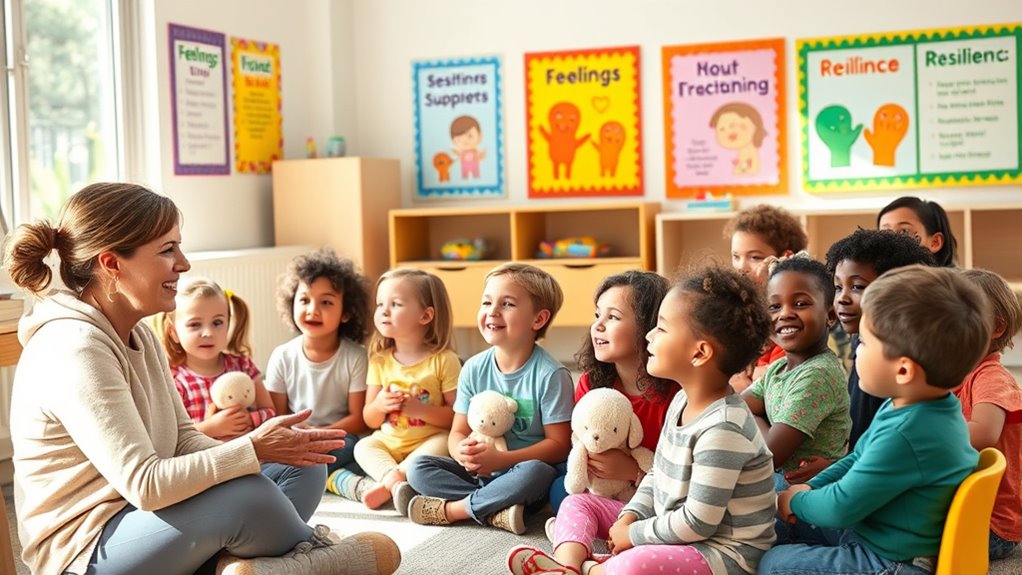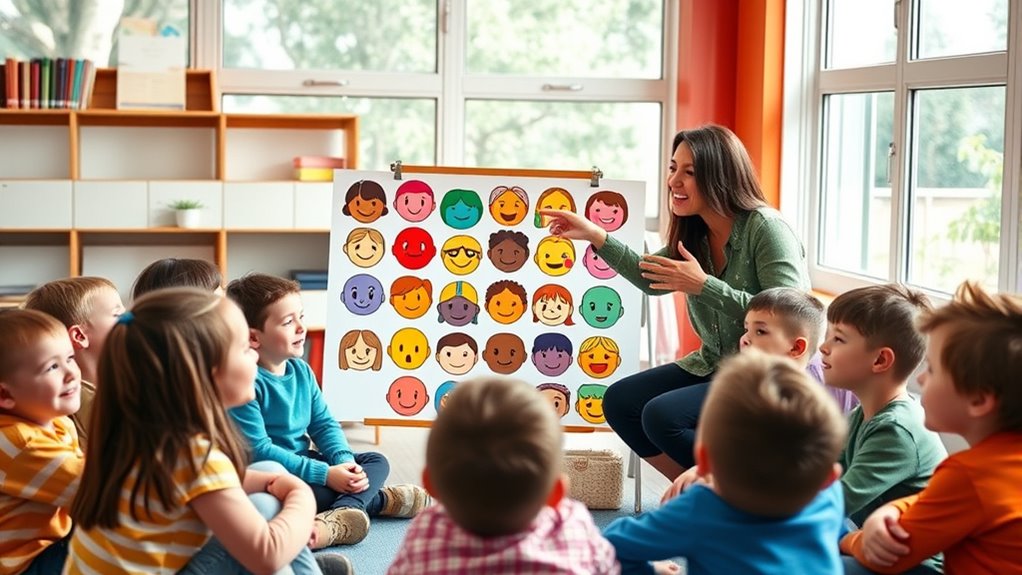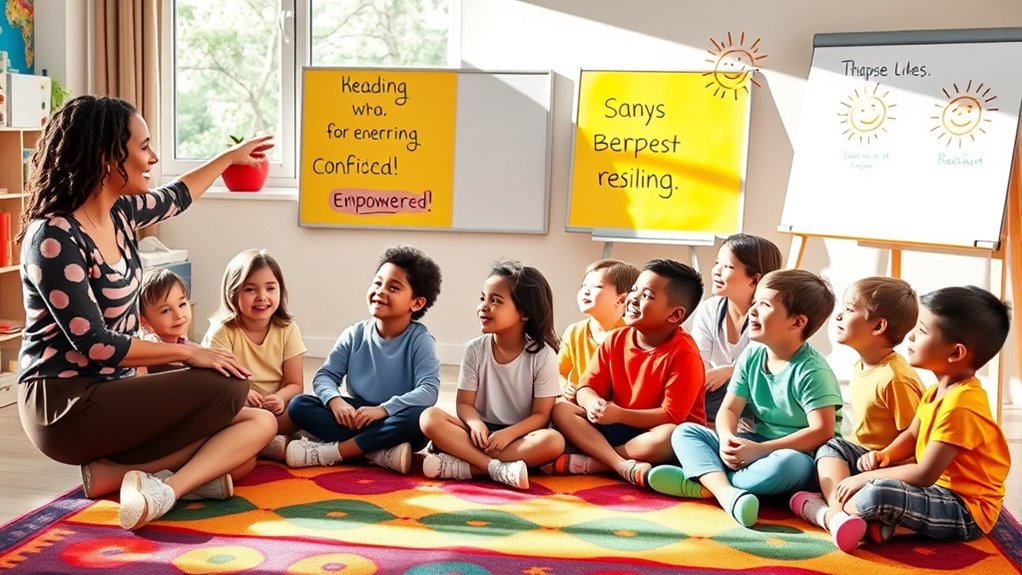To teach children emotional resilience, create a supportive environment where they feel safe expressing their feelings. Help them identify and label emotions using visual cues and vocabulary. Model healthy emotional expression and coping skills like deep breathing and problem-solving. Encourage a growth mindset with positive self-talk and patience. Building strong relationships and community support further strengthens resilience. If you keep exploring, you’ll find more ways to foster emotional strength in children.
Key Takeaways
- Foster a supportive environment encouraging open communication and emotional literacy to help children recognize and express their feelings effectively.
- Teach children to identify, name, and understand emotions using visual cues, emotion vocabulary, and discussion to build emotional awareness.
- Promote healthy coping skills like mindfulness, creative expression, and problem-solving to help children manage stress and setbacks.
- Model resilience by demonstrating calmness, positive self-talk, and adaptive reactions during challenging situations for children to emulate.
- Build strong social support networks through peer support, community activities, and collaboration with caregivers to enhance emotional resilience.
Understanding Emotional Resilience in Children

What exactly is emotional resilience in children, and why is it so important? Emotional resilience refers to a child’s ability to adapt to challenges, setbacks, and stress in healthy ways. It’s closely linked to emotional intelligence, which helps kids understand and manage their feelings effectively. Building resilience isn’t about avoiding difficult emotions but learning to navigate them confidently. Resilience training involves teaching children skills like problem-solving, self-awareness, and mindfulness, enabling them to bounce back from adversity. When you focus on nurturing emotional resilience, you’re helping your child develop a strong foundation for mental well-being. This skill set empowers them to face life’s inevitable ups and downs with confidence, fostering a sense of security and independence that lasts a lifetime. Incorporating anime movies that touch hearts into stories about overcoming difficulties can also inspire children to develop resilience in a relatable way.
Recognizing the Signs of Emotional Struggles

As children develop emotional resilience, they may still experience struggles that signal they’re facing challenges. Recognizing these signs early helps you support them effectively. Look for signs of anxiety, such as excessive worry, fidgeting, or difficulty concentrating. Behavioral cues like withdrawal, irritability, or sudden changes in sleep or appetite can also indicate emotional struggles. Pay attention to their reactions in different situations—if they seem overwhelmed or overly emotional, it’s a sign they might need help processing feelings. These cues aren’t always obvious, so staying attentive and observant is key. Being aware of emotional health indicators can further help in identifying early signs of distress. By noticing these signs early, you can intervene with understanding and support, helping your child navigate their emotions more confidently.
Creating a Supportive Environment at Home and School

You can foster emotional resilience by encouraging your children to share their feelings openly without judgment. Establishing consistent routines helps them feel secure and confident, especially during stressful times. When you combine open communication with predictable schedules, you create a supportive environment that nurtures their emotional growth. Incorporating regular routines into daily life can further reinforce stability and trust.
Encouraging Open Communication
How can creating a supportive environment at home and school foster open communication? When children feel safe and understood, they’re more likely to share their feelings. To encourage this, consider these strategies:
- Promote peer support by facilitating group activities where kids can express emotions comfortably.
- Teach emotional literacy, helping children identify and articulate their feelings clearly.
- Model open communication yourself, showing honesty and active listening.
- Create regular check-ins, offering a dedicated space for children to discuss concerns without judgment.
- Recognize the importance of emotional resilience in helping children navigate their feelings and build trust within their environment.
Building Consistent Routines
Building consistent routines at home and school creates a predictable environment where children feel secure and supported. Establishing regular bedtime routines helps children understand what to expect at the end of each day, easing anxiety and promoting better sleep. Consistent meal schedules ensure they receive proper nutrition and create a sense of stability. When children know when to expect mealtimes and bedtime, they develop a sense of control and trust in their environment. These routines also help children manage their emotions better, as predictability reduces uncertainty and stress. Reinforcing routines consistently teaches responsibility and discipline, laying the foundation for emotional resilience. Additionally, maintaining organized environments can further support children in developing effective coping skills. By maintaining steady routines, you help your child feel safe, confident, and better prepared to handle challenges.
Teaching Kids to Identify and Name Their Emotions

Helping your child recognize and name their emotions is key to building emotional resilience. You can do this by teaching them different emotion words and encouraging them to express how they feel. When kids understand their emotions, they become better equipped to manage them effectively. Incorporating engaging narratives and using immersive soundscapes can also make learning about emotions more relatable and memorable for children.
Recognizing Different Emotions
Understanding your child’s emotions starts with teaching them to recognize and name what they’re feeling. Help them observe differences in facial expressions, such as a smile indicating happiness or a frown showing sadness. Use color recognition to connect emotions, like red for anger or blue for sadness. To make this easier, try these steps:
- Show pictures of faces with various expressions and ask your child to identify each one.
- Discuss how different emotions might look on their own face.
- Use color-coded charts to associate emotions with colors.
- Encourage your child to describe their feelings by describing facial cues and colors.
- Reinforce the importance of emotion recognition to help children develop emotional resilience and better understand their own feelings.
Using Emotion Vocabulary
How can you guarantee your child effectively communicates their feelings? The key is teaching them to use precise emotion words. Start by choosing simple, clear emotion word selection that matches their experiences. When they can accurately identify and name feelings like anger, frustration, or excitement, they develop a stronger emotional vocabulary. Focus on vocabulary expansion by regularly introducing new emotion words and discussing their meanings. Use everyday situations to model how to label feelings, encouraging your child to articulate what they’re experiencing. This practice helps them become more aware of their emotions and express themselves confidently. Over time, a rich emotion vocabulary empowers children to communicate more effectively, fostering emotional resilience and better understanding of their own feelings and those of others. Recognizing the importance of emotional awareness can further enhance their ability to navigate social interactions successfully.
Encouraging Emotional Expression
Why is it important to encourage your child to identify and name their emotions? When kids recognize their feelings, they gain control and understanding, making emotional expression easier. You can support this through activities like art therapy and emotional storytelling, which help kids explore their emotions creatively. Incorporating discussions about Bitcoin IRA concepts can also introduce them to the idea of managing complex feelings, such as uncertainty or excitement, in a safe environment. Here are some ways to encourage emotional expression:
- Use art therapy to draw or paint feelings, making emotions visible.
- Share emotional storytelling to help children express experiences and feelings.
- Ask open-ended questions about their day and feelings.
- Model emotional expression yourself to show it’s okay to share emotions.
These approaches help children build emotional resilience by making their feelings tangible and understood. Encouraging emotional expression empowers them to navigate their emotions confidently.
Developing Healthy Coping Strategies and Problem-Solving Skills

Building healthy coping strategies and strong problem-solving skills is essential for helping children navigate life’s challenges effectively. You can teach kids to use mindfulness practices to stay grounded during stressful moments, encouraging them to breathe deeply or focus on the present. These techniques improve stress management and create a sense of calm, making it easier for children to approach problems rationally. Encourage them to identify their feelings and consider solutions instead of reacting impulsively. Practice scenario-based problem-solving together, guiding them through evaluating options and consequences. Reinforcing these skills helps children develop resilience, equipping them to handle setbacks with confidence. Additionally, introducing them to effective tools like painting or drawing can provide healthy outlets for expression and emotional regulation. By fostering healthy coping strategies, you support their emotional growth and empower them to face future challenges with resilience.
Encouraging Growth Mindset and Positive Self-Talk

Encouraging a growth mindset and positive self-talk helps children develop resilience by shifting their focus from fixed abilities to their potential for growth. When kids believe they can improve through effort, setbacks become opportunities to learn. To foster this, try these strategies:
Foster resilience by promoting growth mindset and positive self-talk to help children see challenges as opportunities.
- Praise effort, not just results, to reinforce a growth mindset.
- Teach children to replace negative self-talk with empowering phrases like “I can try again.”
- Share stories of perseverance to inspire resilience.
- Model positive self-talk in your own behavior to demonstrate its importance.
Modeling Emotional Resilience Through Adult Behavior

Have you ever considered how your behavior directly influences your child’s ability to handle setbacks? Your actions serve as powerful adult role modeling, shaping how they respond to challenges. When you demonstrate emotional resilience, you teach them that setbacks are manageable and temporary. For example, showing calmness during stressful situations or openly expressing your emotions in healthy ways provides an emotional demonstration they can emulate. Children learn by observing, so your reactions influence their understanding of emotions and coping strategies. By staying composed and handling difficulties with patience, you set a strong example. This consistent emotional demonstration helps children develop resilience, equipping them to face their own obstacles with confidence and adaptability. Your behavior, more than words, builds their emotional strength.
Building Strong Relationships and Support Networks

Your consistent display of emotional resilience not only influences how your child learns to cope but also highlights the importance of strong relationships and support networks. Building these connections helps children feel secure and supported. You can foster this by encouraging peer mentorship, where children learn from and support each other. Community engagement also plays a essential role, providing opportunities for children to connect with others outside their immediate family. Consider these strategies:
- Facilitate peer mentorship programs at school or in the community
- Encourage participation in group activities and clubs
- Create opportunities for children to volunteer or serve others
- Maintain open communication with teachers and community leaders
These efforts strengthen your child’s support network, promoting resilience and emotional well-being.
Incorporating Activities That Promote Emotional Development

Incorporating activities that promote emotional development helps children recognize and express their feelings effectively. Engage them in games like role-playing or storytelling to improve emotion regulation and social skills. These activities encourage children to identify their emotions and learn appropriate responses, fostering self-awareness. You can also introduce mindfulness exercises, such as deep breathing or guided imagery, to help them manage strong feelings. Group activities, like cooperative play or team projects, teach children how to navigate social interactions and build empathy. Consistent practice of these activities strengthens their emotional resilience, making it easier for them to handle setbacks and conflicts. By intentionally incorporating such exercises into daily routines, you support their ongoing emotional growth and social competence.
Frequently Asked Questions
How Can Parents Effectively Handle Their Own Emotional Struggles Around Children?
When facing your own emotional struggles around children, focus on parental self-awareness to identify your feelings. Set clear emotional boundaries to protect both yourself and your child. Communicate honestly and calmly, avoiding taking out frustrations on your kid. Practice self-care and seek support if needed. By managing your emotions effectively, you create a healthier environment, modeling resilience and teaching your child valuable emotional skills.
What Role Does Cultural Background Play in Teaching Emotional Resilience?
Cultural background is the foundation of your child’s emotional garden. It shapes your beliefs about emotional expression and influences how they learn resilience. When you understand your cultural values, you can teach them to navigate feelings with respect and confidence. By blending traditions with open communication, you help your child build resilience that honors their roots while fostering emotional growth. Your cultural lens becomes a powerful tool in shaping their emotional strength.
How Early Should Emotional Resilience Education Begin in Childhood?
You should start teaching emotional resilience as early as possible in childhood development. Introducing emotional literacy during toddler years helps children recognize and manage feelings from a young age. Early education builds a strong foundation for resilience, enabling kids to handle challenges better later in life. The sooner you foster emotional understanding, the more confident and adaptable they’ll become, setting them up for healthier emotional well-being throughout their growth.
Are There Specific Books or Resources Recommended for Teaching Emotional Resilience?
You should explore books and resources that use storytelling techniques and mindfulness exercises to teach emotional resilience. Look for stories that help children identify feelings and develop coping skills, like *The Invisible String* or *Anh’s Anger*. Incorporate mindfulness exercises, like breathing techniques, to reinforce emotional awareness. These tools engage children actively, making resilience-building both fun and effective. Using these resources regularly helps children develop essential emotional skills early on.
How Can Schools Collaborate With Parents to Support Children’s Emotional Growth?
You can strengthen school home communication by creating open, trusting channels for ongoing dialogue. Encourage collaborative programs that involve parents in emotional growth activities, fostering a unified approach. When schools and families work hand-in-hand, they nurture children’s resilience more effectively. Regular updates, family workshops, and joint goal-setting help build a supportive environment. Together, you create a foundation where children feel understood, safe, and empowered to develop emotional strength.
Conclusion
By fostering emotional resilience in children, you give them the tools to handle life’s challenges confidently. It’s natural to worry about whether they’ll always succeed, but remember, building resilience is a process. With your support, patience, and guidance, your child can develop the strength to bounce back and thrive. Start today—your consistent effort makes a lasting difference in their emotional well-being and future success.









